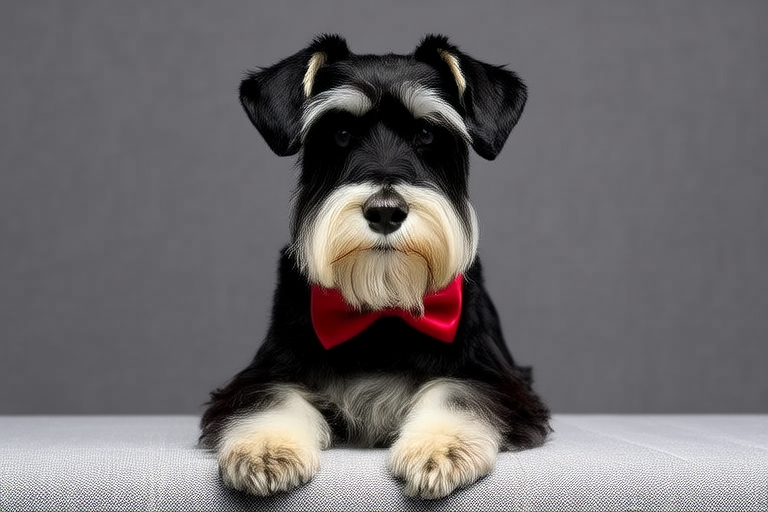The Ultimate Guide to Training Your Spirited Schnauzer Pup
Welcome to the world of spirited Schnauzers! These intelligent and energetic dogs can be both delightful companions and challenging pets if not properly trained. This comprehensive guide will walk you through everything you need to know about training your spirited Schnauzer pup. From understanding their behavior to mastering basic commands and addressing common challenges, this article aims to provide you with all the tools necessary to raise a well-behaved and happy Schnauzer.
Understanding Schnauzer Behavior
Schnauzers are known for their lively personalities and sharp intelligence. They are highly alert and curious, traits that make them excellent watchdogs but also require consistent training to channel their energy into positive behaviors. Understanding your Schnauzer’s natural tendencies is key to successful training. For instance, they tend to be protective of their territory and family, which can sometimes manifest as barking or aggression towards strangers.
A common scenario involves a visitor ringing the doorbell, triggering your Schnauzer’s protective instincts. Instead of allowing this behavior to escalate, it’s important to teach your pup that visitors are welcome and should not provoke fear or anxiety. By consistently rewarding calm behavior during such situations, you can help your Schnauzer understand that there’s nothing to worry about.
Essential Training Tips
Training a Schnauzer requires patience, consistency, and positive reinforcement. Start by establishing yourself as the leader of the pack, setting clear boundaries from day one. Use treats and praise to reward desired behaviors, making training sessions short (10-15 minutes) but frequent throughout the day. Keep training sessions fun and engaging to maintain your pup’s interest and motivation.
For example, when teaching your Schnauzer to sit, hold a treat above its nose and slowly move it back over its head, prompting the pup to lower its bottom. As soon as your Schnauzer sits, give the command “Sit” and immediately reward with a treat and verbal praise. Repeat this process several times until your pup associates the command with the action.
Basic Commands
Mastery of basic commands is crucial for any dog owner. Some fundamental commands include:
- Stay: Hold a treat in front of your Schnauzer’s nose and say “Stay.” Take a step back while keeping eye contact. If your Schnauzer stays put, reward with a treat and praise. Gradually increase the distance and duration of the stay command.
- Leave It: Place a treat or object on the ground and cover it with your hand. Say “Leave It” and wait for your Schnauzer to stop trying to get it. Once they show no interest, remove your hand and reward them with another treat from your pocket.
- Drop It: If your Schnauzer has an item in its mouth, say “Drop It,” then offer a more desirable treat. When your pup drops the item, give the treat and plenty of praise.
Socialization Techniques
Socializing your Schnauzer is vital for developing good manners and ensuring they become comfortable around different people, animals, and environments. Expose your pup to various stimuli early on, including sounds, sights, and textures. Arrange playdates with other friendly dogs, visit parks, and take them on car rides to get them accustomed to different experiences.
A practical tip is to introduce your Schnauzer to children gradually. Have a friend or neighbor bring their child over for supervised interactions. Encourage gentle petting and playing, praising your pup for calm behavior around kids. This helps build trust and prevents future issues related to fear or aggression.
Common Challenges and Solutions
Despite their intelligence, Schnauzers can present some unique challenges. One common issue is excessive barking. To address this, identify triggers and work on desensitizing your pup to them. For instance, if your Schnauzer barks at every noise outside, gradually expose them to these sounds without reacting. Over time, they’ll learn that these noises aren’t threats.
Another challenge is chewing. Schnauzers are naturally curious and may explore their environment by chewing on inappropriate objects. Provide plenty of appropriate chew toys and redirect their attention whenever you catch them chewing on something forbidden. Consistent redirection and praise for good choices will help curb this behavior.
Exercise Needs
Schnauzers are active dogs that require regular exercise to stay healthy and happy. Daily walks, playtime in the yard, and interactive games like fetch are great ways to meet their physical needs. Aim for at least two 30-minute walks per day, supplemented with additional play sessions indoors or outdoors.
Incorporating mental stimulation is equally important. Puzzle toys, agility courses, and obedience training exercises can keep your Schnauzer mentally engaged and prevent boredom-related behavioral issues. For example, hide-and-seek games where you hide treats around the house can be both entertaining and intellectually stimulating for your pup.
Diet Considerations for Optimal Energy Levels
A balanced diet is essential for maintaining your Schnauzer’s energy levels and overall health. Choose high-quality dog food that meets AAFCO standards and provides adequate protein, fats, carbohydrates, vitamins, and minerals. Consult with your veterinarian to determine the right amount of food based on your pup’s age, weight, and activity level.
Consider incorporating fresh vegetables and fruits into your Schnauzer’s diet as occasional treats. Blueberries, carrots, and green beans are safe options that can add variety and nutrition. Avoid feeding table scraps, especially those containing onions, garlic, chocolate, or grapes, as these can be toxic to dogs.
Maintaining Discipline and Consistency in Training
Consistency is key to effective training. Ensure all family members use the same commands and rewards system. Establish a routine for meals, walks, and training sessions to create structure in your pup’s life. Be patient and persistent, understanding that setbacks are part of the learning process.
If you encounter a particularly stubborn behavior, don’t hesitate to seek professional help. A certified dog trainer can provide personalized guidance tailored to your Schnauzer’s specific needs. Real-life scenarios where professional intervention might be necessary include severe aggression, extreme separation anxiety, or persistent destructive behavior.
Conclusion
Raising a spirited Schnauzer pup can be incredibly rewarding once you understand their unique needs and characteristics. By following the guidelines outlined in this ultimate guide, you’ll be well-equipped to train your Schnauzer effectively, ensuring a harmonious relationship between you and your furry companion. Remember, every dog is different, so tailor your approach to suit your Schnauzer’s individual personality and temperament.



